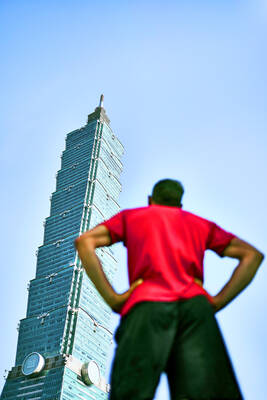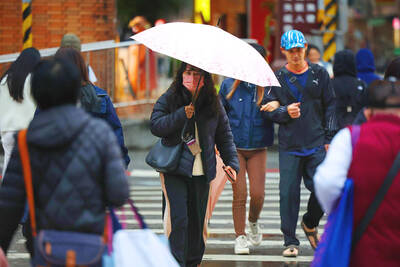The recent US report on China's military power and the growing military imbalance across the Taiwan Strait is aimed at shattering the idea that the cross-strait impasse can be solved peacefully, analysts said yesterday.
The analysts came to this conclusion after interpreting the US report's message and the Chinese government's reactions to it, adding that the report might dampen unificationist elements within Taiwan.
While the cross-strait military imbalance has been a matter of concern for the US, it was conveyed in a different way in the report, said Tsai Ming-yen (
"Unlike the former [US military] reports that merely state the amount of Chinese weapons targeted at Taiwan, the functions and the operations of its weapons are also given attention in this year's report," said Tsai, adding "we should read from this difference that China's military strategy is based on bringing about unification with Taiwan."
"Another point that wasn't mentioned so clearly in the former reports is the China's two-pronged strategy to against Taiwan," Tsai said, referring to a strategy of "persuasion and coercion" as stated in the Pentagon report.
The US doesn't consider China's rise as merely an opportunity to tap its vast market, as its foreign policy clearly shows. This includes asking the EU not to lift an arms embargo against China, blocking Israel's sale of drone aircraft to the authoritarian giant, and enhancing its military cooperation with Japan and India, he said.
These actions prove that the US perceives a rising China as a threat, Tsai said.
"It seems that those aspects of the Chinese military threat, as spelled out in the US report, have not been noticed in Taiwan," Tsai said. "In fact, it's difficult in this country to reach a consensus on the issue because of the bitter partisan rivalry that exists here. That's why the Pentagon sought to remind Taiwan of China's `persuasion strategy' in the report."
Tsai's interpretation was echoed by Chang Kuo-cheng (
Failing to break the deadlock over the arms procurement budget symbolized the pervasiveness of "pro-China thinking" in the country, Chang said, defining such thinking as "placing China's interests before Taiwan's."
Politicians guided by this thinking prefer to pin their all hopes of resolving the cross-strait dispute on all kinds of exchanges activities with China, Chang said.
"I'm not saying that peaceful exchanges don't help the cross-strait situation. The problem is that while the politicians preach the benefits of these activities, they forget about the necessity to build up our own defense capability," Chang said.
Chang noted that by emphasizing the cross-strait military imbalance, the Pentagon wanted to give Taiwan the hint that its political dispute with China won't be easily resolved by peaceful means, given China's fast-growing military and economic clout.
"Not to pin your hopes on a peaceful settlement of the issues doesn't necessarily equal a willingness to have a military conflict," Chang said. "[Investing in defensive weapons] just means that we take the possibility of a military conflict seriously."
He also said that maintaining a sufficient military force and solidifying defense around Taiwan's borders is the report's overriding message.
The Chinese government blasted the US government shortly after the report was released, with China's Deputy Foreign Minister Yang Jiechi (
"China's fierce response to the report shows that its military ambitions -- not only against Taiwan, but also in the region -- are genuine, and that the conclusions reached in the US report are correct," said Yang Chih-heng (楊志恆), an associate professor of Southeast-Asian studies at Tamkang University.
China might think that it was inappropriate for the US to make such strong conclusions about its military expansion, as Washington needs Beijing's help in resolving the North Korean nuclear dispute, Yang said.
The report, to China's surprise, illustrated the fact that the US' China policy is one of engagement and containment, Yang said.
In view of this, the cross-strait military imbalance and Taiwan's complacence toward its defense capability are especially worrying for the US, as they are closely related to the future of that nation's influence in the region, Yang said.

US climber Alex Honnold is to attempt to scale Taipei 101 without a rope and harness in a live Netflix special on Jan. 24, the streaming platform announced on Wednesday. Accounting for the time difference, the two-hour broadcast of Honnold’s climb, called Skyscraper Live, is to air on Jan. 23 in the US, Netflix said in a statement. Honnold, 40, was the first person ever to free solo climb the 900m El Capitan rock formation in Yosemite National Park — a feat that was recorded and later made into the 2018 documentary film Free Solo. Netflix previewed Skyscraper Live in October, after videos

Starting on Jan. 1, YouBike riders must have insurance to use the service, and a six-month trial of NT$5 coupons under certain conditions would be implemented to balance bike shortages, a joint statement from transportation departments across Taipei, New Taipei City and Taoyuan announced yesterday. The rental bike system operator said that coupons would be offered to riders to rent bikes from full stations, for riders who take out an electric-assisted bike from a full station, and for riders who return a bike to an empty station. All riders with YouBike accounts are automatically eligible for the program, and each membership account

NUMBERS IMBALANCE: More than 4 million Taiwanese have visited China this year, while only about half a million Chinese have visited here Beijing has yet to respond to Taiwan’s requests for negotiation over matters related to the recovery of cross-strait tourism, the Tourism Administration said yesterday. Taiwan’s tourism authority issued the statement after Chinese-language daily the China Times reported yesterday that the government’s policy of banning group tours to China does not stop Taiwanese from visiting the country. As of October, more than 4.2 million had traveled to China this year, exceeding last year. Beijing estimated the number of Taiwanese tourists in China could reach 4.5 million this year. By contrast, only 500,000 Chinese tourists are expected in Taiwan, the report said. The report

Temperatures are forecast to drop steadily as a continental cold air mass moves across Taiwan, with some areas also likely to see heavy rainfall, the Central Weather Administration (CWA) said. From today through early tomorrow, a cold air mass would keep temperatures low across central and northern Taiwan, and the eastern half of Taiwan proper, with isolated brief showers forecast along Keelung’s north coast, Taipei and New Taipei City’s mountainous areas and eastern Taiwan, it said. Lows of 11°C to 15°C are forecast in central and northern Taiwan, Yilan County, and the outlying Kinmen and Lienchiang (Matsu) counties, and 14°C to 17°C